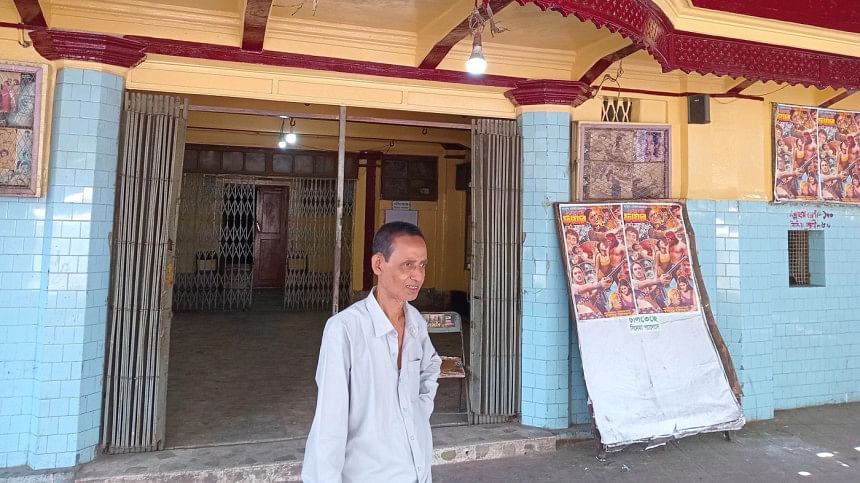The rise and fall of Chattogram’s single-screen cinema halls

Eid holidays in Chattogram city were once synonymous with a cherished tradition: families and friends gathering to enjoy movies in single-screen cinema halls scattered across the city.
After the Eid prayers at the Eidgah and customary greetings with neighbours and relatives in the morning, people would throng the cinema halls in hundreds in the afternoon with a collective yearning for entertainment.
In an era before the internet and private television channels, there were around 30 such cinema halls in the port city that drew crowds eager for cinematic escape amid a vibrant atmosphere -- a trend that flourished well into the 90s.
Moviegoers eagerly waited for Eid holidays, the prime time for producers to release their new films. The demand was so high that cinema halls would compete for the rights to show the new releases, enticing audiences with festive decorations, colourful lighting, better seating arrangement, and a palpable celebratory ambience.
"Enjoying the big-budget films starring Ajim-Sujata, Rahman-Shabnam, and Razzak-Kobori in the cinema halls was a quintessential pastime for people from both city and rural areas in the evenings during Eid holidays," said Abdul Motaleb, 70, a resident of Panchlaish area.
Echoing similar sentiment, Minhaz Uddin Mahmud, a resident of Lalkhan Bazar area, said, "The Eid releases predominantly featured social and family dramas, perfect for family viewing. In our youth in the 1980s, we always made it a point to go to the cinema halls with our families during Eid to watch the films starring Jafar Iqbal-Babita, Wasim-Anju Ghosh, Faruk-Babita, and Alamgir-Shabana. Besides, Sohel Rana and Jasim were very popular as action heroes."

"We had to buy tickets three to four days in advance before Eid, otherwise all tickets were completely sold out for the entire week," Minhaz added.
"In 1993, Keyamat Theke Keyamat was released in the Eid-ul-Fitr, starring Salman Shah and Mousumi. I went to Gulzar Cinema Hall in the Chawk Bazar area with my three friends, but we couldn't get tickets. Later, we managed tickets paying three-time higher price," said Kamal Uddin, a resident of Bakalia DC Road area.
However, the golden days of cinema halls are long gone. Of the nearly 30 halls in the port city, only three are currently operational. Of those, only one is operating as a single screen, one has been turned to multiplex, and the remaining one is also going to be renovated to multi-screen theatre.
Many of the cinema halls were demolished to make way for construction of multi-storied buildings and shopping malls, said Abul Hossain, president of the Chattogram Cinema Hall Owners' Association.
"The demolitions began in late 1990s when audiences turned away their faces after vulgarity crept into the film industry. The rise of private TV channels and availability of films online further contributed to the decline of single screen cinema halls," he explained.
Abul Hossain owns two of the remaining three single screen cinema halls in the port city -- Cinema Palace and Sugandha (formerly Jhumur Cinema Hall). Of those, Sugandha is being renovated into a multi-screen theatre.
Recalling Eid days between 1970s and 1990s, Abul said, "All cinema halls would take on a festive appearance. Owners were jubilant in hope of good business, and staffers were happy as they received attractive bonuses."
"The number of viewers often exceeded the seating capacity, so we had to arrange extra seats for almost every show. Some people would even remain standing to watch a film spanning over two and half hours," he also said, stressing how much people craved the cinema experience back then.
According to movie experts and business leaders, audiences are n longer drawn to traditional cinema halls as their tastes have evolved and most people now seek a more comfortable atmosphere, improved sound systems and screens that enhance their viewing pleasure.
Aolad Hossain Uzzwal, general secretary of Bangladesh Motion Picture Exhibitors' Association, said a total of 1,200 cinema halls have closed across the country in the past 20 years, leaving only around 200 struggling to survive.
"The concept of traditional cinema halls is now 70 years old. While people still want to enjoy movies on a big screen, they like to do so in comfort," he said.
Keeping the audiences' demands in mind, multiplexes are being developed in Dhaka. Chattogram, the second-largest city and commercial capital, is also witnessing this trend.
Silver Screen, the first multiplex in Chattogram, commenced its journey in July 2018 at Finley Square in Sholashahar area, and has been attracting a significant audience.
Star Cineplex, another multiplex, was launched in the port city in December 2022 at Bali Arcade Shopping Complex in Chawk Bazar area.
Uzzwal, however, opined that multiplexes are not enough to draw audience unless a good number of quality movies are released throughout the year.
"The recent success of movies like Poran, Hawa, Surongo and Toofan clearly demonstrates this," he added.

 For all latest news, follow The Daily Star's Google News channel.
For all latest news, follow The Daily Star's Google News channel. 



Comments